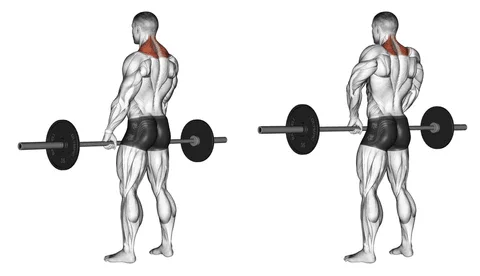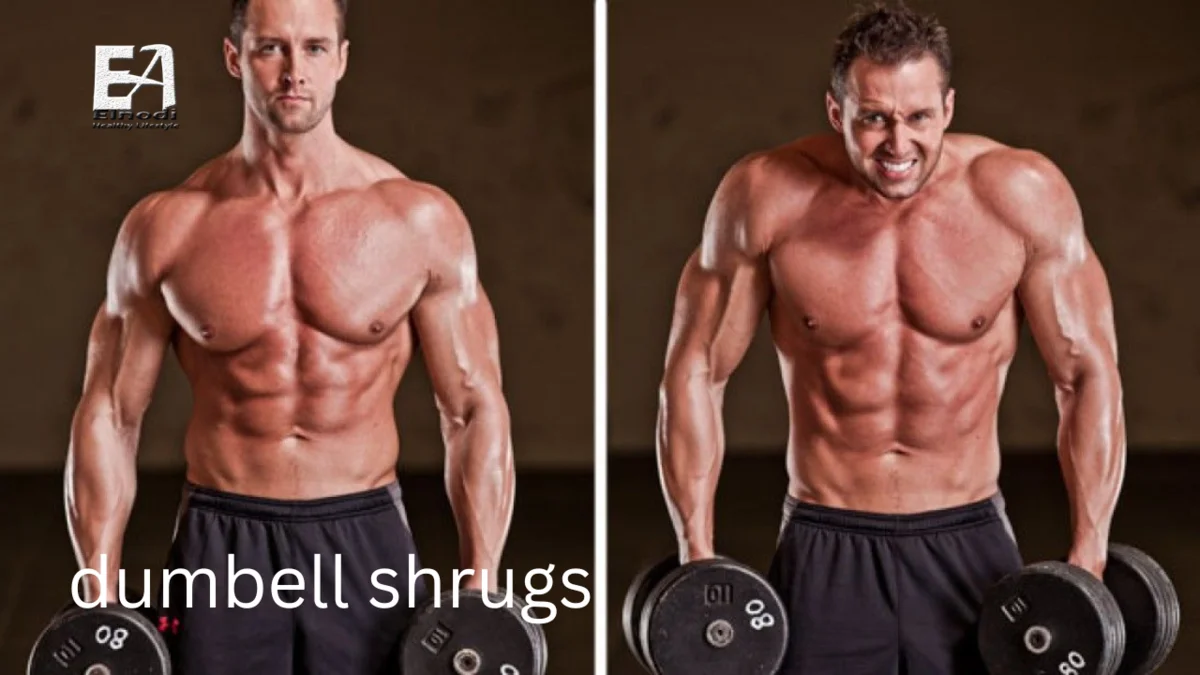A Dumbbell shrug is an easily done and extremely effective shoulder toning exercise that you can perform with just a pair of dumbbells. The motion engages all the major muscles in your upper body, including your biceps, chest, core, and shoulder muscles. Moreover, they are an excellent choice for people who want to build muscle while losing weight or improving overall fitness levels. (1)
What is the Dumbbell Shrug?
The dumbbell shrug is a closed kinetic chain isolation exercise that targets the trapezius muscles on the back and shoulders. It is defined as a pull movement, with the forearms and deltoid heads acting as stabilizers during the exercise.
The dumbbell shrug is a relatively safe exercise that can be added to any workout routine or physical rehabilitation plan to induce a certain level of stimulation and activation in the trapezius muscles, which can otherwise be difficult to activate on their own.
The Benefits
Dumbbell shrug and developing stronger traps will help your deadlifts, carries, overhead presses, rows, and pull-ups, to mention a few. A Dumbbell shrug may also be effective in alleviating neck pain, according to research. The shrug is simple to perform, so if you’re a beginner with a set of dumbbells, you may try it from the comfort of your own home.
To get the most out of the dumbbell shrug, the correct technique is required. It also protects your shoulders from damage. (2)
According to Samuel, ‘Bro science (or at least some of it) indicates that when shrugging, you should look at the ground. In principle, this allows you to work the traps across a wider range of motion. But don’t fall for it.’
Muscles worked

Although the traps are the primary muscle targeted by this shrug exercise, the rhomboids and forearm muscles also play a role.
trapezius
The trapezius is a big muscle found on the upper back and neck that is separated into three portions that control scapula (shoulder blade) movement and neck extension. The upper traps, in particular, lift and rotate the scapula upward, as well as stretch the neck, like when you bend your head forward.
The middle traps bring the shoulder blades closer together, whilst the lower traps descend the scapula and aid with forward rotation. From a practical standpoint, the traps assist your delts in throwing objects and raising your arms above your head. Because the arms and shoulders frequently operate together, the traps are essential for practically all upper body movement.
rhomboids
The rhomboids are major and minor muscles located right behind the trapezius muscles that largely contribute to scapula movement. They also help to stabilize the shoulder joint and protect the scapula. The rhomboid, together with other muscles such as the levator scapulae, supports shoulder blade retraction, elevation, and rotation. Any exercise that draws your shoulder blades closer together (retraction) will effectively target your rhomboids.
forearm Muscles
They may not benefit as much from this exercise as they would from plate pinches or a towel pull-up, but the forearms are required to maintain the weight of the dumbbells. Your brachioradialis will be especially active. (3)
How to do

Instructions
- Take a stance with the dumbbells on both sides of your body.
- Hinge forward, inhale, and take a neutral hold on the dumbbells.
- Maintain a neutral spine by standing tall.
- To raise the shoulders, contract the traps. Squeeze the dumbbells firmly at the top and slowly lower them back to the starting position.
- Repeat until the desired number of repetitions has been reached.
Dumbbell Shrug Tips
- Because traps assist to restrict head mobility, looking slightly up while shrugging may help to improve the contraction. A ballistic movement could result in a neck injury, thus this action should be smooth and controlled.
- High reps and explosive movements (e.g., snatch grip high pulls) tend to stimulate the traps, so plan your accessory training accordingly.
- Limit the weight’s momentum and jerking or bouncing. Nobody cares how much you shrug.
- Allowing the head to lean forward excessively while you squeeze the traps can put the neck in jeopardy and result in damage.
- Including a pause at the top of the action can aid in improving the mind-muscle connection.
Common Mistakes
- Not maintaining correct form. The lifting motion should come totally from your shoulders and traps, with your arms straight and passive. The shoulders should move straight up and down, not forward and backward.
- Picking the wrong weight. This is an exercise where it’s easy to pick both a weight that’s too heavy, which can lead to difficulties with keeping a proper form, and a weight that is too light. If you feel like the grip strength is what’s holding you back from picking a heavier weight, don’t hesitate to use lifting straps.
Shrug Variations
Barbell Shrugs

The key difference with the barbell shrug is that your grip will be pronated (palms facing away from you) rather than neutral. However, this does not preclude you from keeping your chest open and completing the reps with proper form. Begin by deadlifting the bar up to a straight position with the bar in front of you. Before completing the rep, imagine breaking the barbell by drawing your shoulder blades back. Raise your shoulders while maintaining your head straight. Squeeze the traps and gently and carefully reverse the movement back down to avoid jolting.
Trap-Bar Shrugs

Trap bar shrugs are preferred to barbell shrugs because the handles are at your sides, allowing for a neutral grip. It’s also advantageous to be able to distribute weight evenly throughout the body in order to encourage standing tall rather than leaning forward. Begin by deadlifting the trap bar up to a standing position. Lift your shoulders up and engage your traps at the apex of the exercise. Hold for one beat, then reverse.
Single-Arm Shrugs
The single arm shrugs, like the dumbbell shrug, only train one side. This forces your core to work harder, preventing you from bending sideways. Begin with the dumbbell at your side, keeping your core engaged to prevent any side-leaning. Shrug one shoulder up while maintaining your torso steady. Lower the dumbbell slowly back to your side.
Dip Shrugs
Maintain your body weight with this dip version, which targets the serratus muscle and ensures your legs aren’t aiding you during the exercise. Find two parallel bars on which to support your weight. Place one hand on each and elevate your feet entirely off the ground. A foot of distance is sufficient. Now concentrate on your traps and shrug. Make sure you’re not dipping like a tricep dip or any comparable workout. To complete one rep, return to the starting position.
How Many Sets and Reps Should You Do in the Dumbbell Shrugs?
The traditional guideline is to use heavy weights and do 1-5 reps per set if you want to build your strength, and moderately heavy weights and do 6-15 reps per set if you want to gain both strength and muscle.
The dumbbell shrug typically lends itself best to the medium rep range of 6–15 reps, as any heavier dumbbells can become very impractical. It is also a little easier to control the technique and perform dumbbell shrug with proper form in the medium rep range.
The amount of sets you should complete of dumbbell shrug depends on how much other trapezius training you undertake during the week as well as your fitness level.
Generally speaking, if you don’t already do plenty of training for your trapezius and you are fairly new to training, a good starting point is to do around two to three sets of dumbbell shrug per workout, up to a max of about ten sets per week.
As you become more comfortable with the exercise, you may want to add a few additional sets to your total training volume. However, this is dependent on your entire exercise volume.
dumbbell shrugs Vs Barbell shrugs
The most popular version of this exercise is barbell shrugs. Both are quite similar, yet they do not provide the same benefits. As previously stated, dumbbells provide a broader range of motion. You can only go as far as the bar allows with a barbell. Dumbbells are more open, which is fantastic if you’ve performed the exercise enough to do it correctly. The barbell will most likely let you manage more weight, which will be useful if you want to do a power shrug, which we’ll go over in more depth momentarily.
You may also experiment with different grip widths on a barbell, though it won’t have as much of an effect as it would with, say, a bench press. The dumbbell version places far less tension on the lower back, so if you have pain or a history of damage there, that’s the one to use. Because dumbbells don’t allow you to work with as much weight, you’re less likely to make some of the form mistakes we discussed before, and you can get a sense of how it feels to lift with your traps.
That’s why it’s best to start with dumbbells when learning how to shrug properly. Even if you eventually switch to barbells or decide they’re more fun, you’ll have perfected the form and will see superior results.
FAQs
what is the difference between a shrug and a power shrug?
Are power shrugs good for traps?
Should I go super heavy on shrugs?
are shoulder shrugs effective?
References
1. Turner, M. C., & Cheney, R. (2016). An Innovative Shrug Apparatus: Is the ISA More Effective in Upper Trapezius Development than Traditional Dumbbell Shrugs?
2. Walker, C. R. (2004). Designing delts: improve your V-taper with Jamo Nezzar’s 4 keys to complete shoulder development. Joe Weider’s Muscle & Fitness, 65(1), 102-107.
3. Javorek, I. (1987). EXERCISE TECHNIQUES: Shrugs. Strength & Conditioning Journal, 9(6), 28-33.





